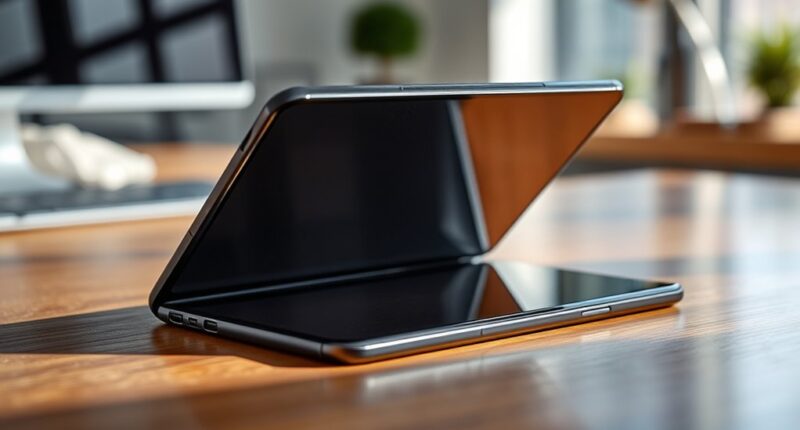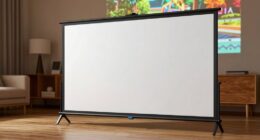Foldable screens work by combining flexible materials like polyimide or ultra-thin glass with layered structures such as OLEDs, which emit their own light for vibrant images. These layers are designed to bend without breaking, supported by special hinge mechanisms that distribute stress evenly. This tech allows your device to transform from a big screen to a compact form easily. If you keep exploring, you’ll discover how these innovations make foldable screens so durable and versatile.
Key Takeaways
- Foldable screens use flexible materials like OLED and polyimide to bend without breaking.
- The layered structure includes a substrate, OLED, TFT, and cover layer designed for flexibility.
- Hinge mechanisms evenly distribute bending forces, protecting delicate display components.
- Organic OLED layers emit their own light, eliminating the need for backlighting and allowing smooth folding.
- Durable materials and engineering enable screens to withstand repeated folding and unfolding cycles.

Have you ever wondered how foldable screens work and what makes them different from traditional displays? The key lies in their flexible display technology, which allows screens to bend, roll, or fold without breaking. Unlike flat screens, these displays are built with special materials and layered structures that provide both flexibility and durability. Technologies like organic LED (OLED), electronic ink, Gyricon, and Organic LCD are used to create these adaptable screens. They’ve already found their way into electronic paper wristwatches and are rapidly evolving, expanding into smartphones, car dashboards, wearable devices, and other innovative form factors.
Foldable screens use flexible materials and layered structures like OLED for durable, bendable displays.
The core of a foldable screen is its layered structure. The foundation is the substrate layer, usually made of a flexible polymer like polyimide, which offers mechanical strength and thermal stability. Sitting on top is the thin-film transistor (TFT) layer, which controls how pixels light up, ensuring sharp images and smooth motion. Above that, the OLED layer contains tiny red, green, and blue subpixels that emit their own light, allowing for high contrast, vibrant colors, and energy efficiency. The entire stack is sealed with a cover layer made from polyimide or ultra-thin glass (UTG), which protects the delicate inner layers while remaining flexible.
OLED technology is especially advantageous for foldable screens because each pixel emits its own light, removing the need for bulky backlighting. This makes screens thinner, which is vital for folding without cracking. Plus, because each pixel can be controlled individually, the display offers high contrast ratios and rich colors. The organic compounds used in OLED layers are designed to withstand repeated bending, ensuring the display remains vibrant over time. This is achieved through innovative organic materials that are engineered to resist fatigue and maintain performance even after many folds. Additionally, ongoing research in flexible display materials continues to enhance durability and performance, pushing the boundaries of foldable technology.
Materials play a significant role in the durability and flexibility of foldable screens. Polyimide polymers are popular for their strength and flexibility, while ultra-thin glass (UTG) is increasingly used as a cover layer due to its toughness and glass-like feel. Plastic covers are cheaper but less scratch-resistant. The organic materials in OLED layers are carefully formulated to resist degradation from repeated bending, balancing flexibility and longevity.
Foldable devices also rely on sophisticated hinge mechanisms. These hinges are designed to allow smooth folding and unfolding while protecting the delicate display from dust, water, and mechanical stress. They distribute bending forces evenly to prevent damage to pixels or layers. The durability of hinges is tested through thousands of open and close cycles, ensuring they last as long as the device itself. Together, these advanced materials and mechanical designs enable a seamless transition from a compact phone to a larger tablet, making foldable screens a versatile and innovative technology.
Frequently Asked Questions
How Durable Are Foldable Screens Over Time?
Foldable screens are quite durable over time, especially with proper care. You can expect modern models to withstand hundreds of thousands of folds, often lasting around 5 to 10 years with daily use. However, they’re still vulnerable to impacts, scratches, and debris. To maximize their lifespan, use protective cases, avoid excessive bending, and handle them gently. Regular maintenance and updates also help keep your foldable screen in good shape longer.
Can Foldable Screens Be Repaired Easily?
You might wonder if foldable screens are easy to repair. They’re not, because they require specialized skills, tools, and careful handling. Disassembling involves delicate steps like heating, grounding, and precise separation of fragile layers. Replacing or repairing the display demands micro soldering and specialized adhesives. Plus, calibration of sensors and hinges can be tricky. Overall, repairs are complex, often costly, and best handled by experienced technicians.
Do Foldable Screens Consume More Battery?
Yes, foldable screens do tend to consume more battery. When you use the larger, unfolded display, it requires more power to light up all those pixels and support higher refresh rates. Additionally, the extra components and dual screens increase overall energy demands. To offset this, manufacturers include larger batteries and optimize software, but expect shorter battery life compared to traditional phones, especially during heavy usage or gaming.
Are Foldable Screens More Prone to Damage?
You’re wondering if foldable screens are more prone to damage. Yes, they are more vulnerable because of their flexible materials and delicate inner displays, which can scratch, crack, or break more easily than traditional screens. The hinges and folding mechanisms also face wear from repeated use and exposure to dust or debris. To keep your device safe, handle it carefully, avoid harsh environments, and use protective accessories.
How Do Foldable Screens Impact Device Weight?
Foldable screens do add some weight to your device, but manufacturers optimize materials to keep it light. You might notice a slight increase due to larger, durable displays and protective glass layers, but innovations like lightweight titanium and advanced hinge technology help offset this. Overall, the balance between durability and weight means your foldable stays manageable, so you can enjoy a bigger screen without sacrificing portability.
Conclusion
Now that you understand how foldable screens work, you can appreciate the blend of innovation and engineering behind them. These screens are truly a demonstration to how technology evolves to meet our needs, making devices more versatile and portable. As the saying goes, “A chain is only as strong as its weakest link,” reminding us that every tiny detail in design matters. Embrace these advancements, and stay curious about what’s next on the horizon.









